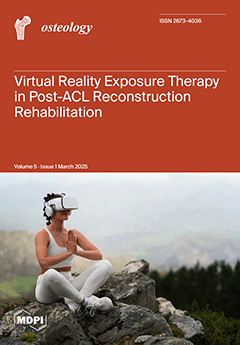Background/Objectives: Cruciate ligament injuries, particularly those involving the anterior cruciate ligament and posterior cruciate ligament, are common among active individuals and often require surgical reconstruction followed by intensive rehabilitation to restore knee stability, movement, and strength. Virtual reality exposure therapy has emerged as a potentially beneficial adjunct to traditional rehabilitation, offering immersive, interactive environments that may aid in pain relief, balance, proprioception, and functional recovery. This meta-analysis aimed to evaluate the efficacy of VRET compared to conventional rehabilitation for postoperative cruciate ligament reconstruction, focusing on outcomes in pain, balance, proprioception, and the knee flexion range of motion.
Methods: A systematic review and meta-analysis were conducted following the PRISMA guidelines and registered in PROSPERO (CRD42024604706). A comprehensive search across databases including MEDLINE (
PubMed), SPORTDiscus, ScienceDirect, Web of Science (
WOS), Cochrane Library, Scopus, and EBSCOhost included studies from inception until the date of search, using terms such as “cruciate ligament”, “virtual reality”, “rehabilitation”, “pain”, and “balance”, combined with Booleans “AND” and “OR”. Methodological quality, risk of bias, and recommendation strength were assessed using
PEDro Scale, Cochrane Risk of Bias Tool (
RoB 2.0), and
GRADE, respectively.
Results: Eleven studies (n = 387) met the inclusion criteria, involving patients who had undergone ACL or PCL reconstruction. Virtual reality exposure therapy showed significant benefits in reducing pain intensity [SMD = −2.33, 95% CI: −4.24 to −0.42, Z = 2.40,
p = 0.02], improving proprioception, and enhancing the knee flexion range of motion. However, the results for static balance [SMD = −0.37, 95% CI: −1.62 to 0.88, Z = 0.58,
p = 0.56] and dynamic balance [SMD = −0.37, 95% CI: −1.83 to 1.09, Z = 0.50,
p = 0.62] were mixed and not statistically significant.
Conclusions: Virtual reality exposure therapy is an effective adjunct therapy to postoperative rehabilitation for cruciate ligament reconstruction, particularly in reducing pain and enhancing proprioception. However, the small sample sizes and variability across studies underscore the need for further research with larger cohorts to validate these benefits in diverse patient populations.
Full article



